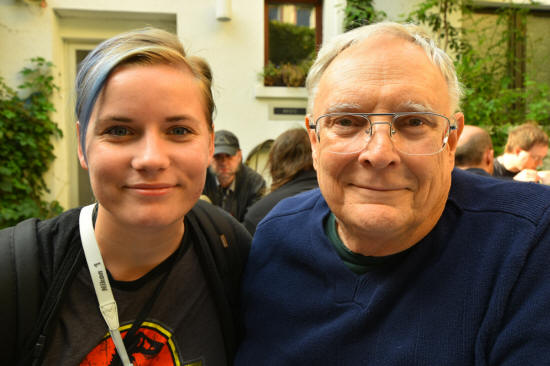Paul Rayton In Conversation |
Read more at in70mm.com The 70mm Newsletter |
| Transcribed and prepared for in70mm.com: Mark Lyndon, in70mm.com. Interviewed and photographed by: Thomas Hauerslev, in70mm.com. Condensed and edited for clarity by: The man himself | Date: 09.02.2020 |
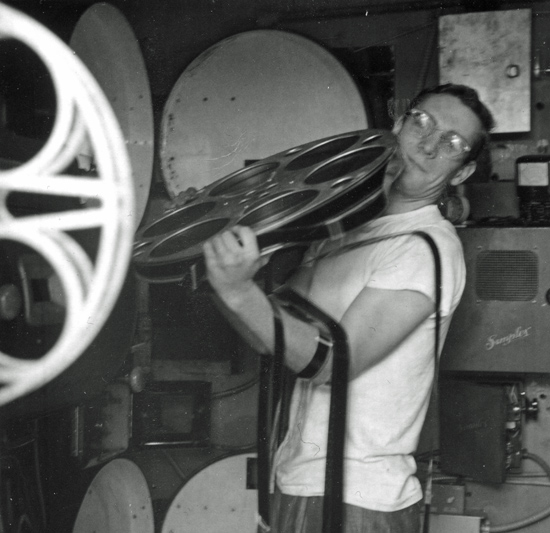 Paul
Rayton [holding a large reel] - summer of ~ 1964, at a summer-only cinema in
Lake George, NY. Paul
Rayton [holding a large reel] - summer of ~ 1964, at a summer-only cinema in
Lake George, NY. Thomas Hauerslev: You were born in 1942; in 1952, Cinerama opened and with some luck, your parents took you to see Cinerama. Do you have any recollections of Cinerama in '52? Paul Rayton: Amazingly (and sadly), not a bit! In the early fifties, I lived a long way from any major motion picture exhibition. The first I heard about it was reading in LIFE Magazine in October of '52, with the pictures that went with it. I had zero clue in '52. I was ten years old. I'm a kid at that point, and living in a town without any kind of "deluxe" cinema at all. THa: Where was this? PR: Hanover, in the eastern U.S. state of New Hampshire. It's a small town, notable mostly for being the location of Dartmouth College, which is often among lists of top-ranked colleges. Hanover was about 150 miles from Boston, and almost 300 miles from New York City, and in the days before express highways, these were formidable driving distances. Boston was probably -- just taking a guess -- five hours one way by car. So movies and film technology were just not "on my radar". I really didn't know much about "the movies". My father, a professor of Physics at the college, died in 1957 when I was 15, and suddenly I was the senior male in the family. We were an academic family, and my destiny was to go for advanced education, so I didn't have to drop out of school and start to work. But I did become entrusted with the family camera, so photography was suddenly handed to me. I didn't know much about focus knobs, exposure settings, and all those little troublesome details for successful photography! Some early efforts were really awful! I played around with a still camera, and a basic 8mm movie camera, and gradually got familiar with them. I made a couple of mini-shorts featuring my younger brother, but my career didn't build from those projects the way Steven Spielberg's did! THa: How did you get interested in running films? Did you go to the movies? PR: Again, I have to reveal a certain degree of early innocence. Our town, in the early 1950s, had somewhere around only 6,500 residents (not counting the ~2,500 college students), and only one cinema, which was operated by the town. I liked to go see shows, but my family was a bit old-fashioned and my mother didn't want me to turn into some kind of "juvenile delinquent", that being a new term at the time which had somewhat evolved out of ... the movies. "Blackboard Jungle", in 1955 kind of brought that subject to the public, so I'd get kind of quizzed before I'd be cleared to see a show, esp. after dad had died. "Why should you see that? Is it too 'adult' for someone your age?" But usually, if I chose carefully, I could see movies. And, at home, I could play with our 8mm projector and an old slide [transparencies, or diapositives - ed.] projector, and experience a bit how they worked. So, one day, somehow or other, probably in about early 1958, it seemed that a local civic organization was going to be having a bit of a gathering at a local meeting hall. They were going to be showing some slides of some member's vacation trip. Somehow I got asked to be the projectionist for the event. It was my first solo "job" outside the home. (I'd been tasked with jobs at home for some time while dad had been sick, like painting, putting up the winter exterior windows, and loading coal into the furnace to keep the heat on.) The projection equipment for the slide show was set up by someone from the college AV department, and all I did was run the slides. But afterwards, I met the man who was the head of the college AV department, Blair Watson, and he asked if I might be occasionally available to help out with other shows on the college campus, as well. At this point, I was in 10th grade, and already had become involved with the Audio-Visual Club in my high school, so this was like magic -- you mean, I'd be earning money for running a projector? How could I not do it?!? The Audio-Video club in high school had quite a number of kids who helped run 16mm movies in classrooms. We'd haul over a heavy old Bell & Howell 16mm projector, and usually a screen, and set it up, run the little speaker & cord to the front of the room, and show the film for the classes. Typical "educational" movies of the era -- "How Butterflies Grow", or "How to Make Things with Woodworking Tools", etc. That stuff we did in school to help out, and for the experience of it -- and possibly getting a excuse pass from some other class, to do the helping with the show! So, I started doing a few projection jobs for the college, mostly on weekends. They had a rather basic auditorium in a building known as Fairbanks Hall. It was set up with about 150 seats as a viewing classroom, for lack of a better term, with a pair of 16mm projectors. It could serve as a small lecture hall, and it had the projectors upstairs, behind glass ports, just like a real cinema. Since the local town cinema would only handle an occasional foreign film, the college would arrange some occasional screenings, esp. of titles that would perhaps be part of the studies in certain college Departments. New Hampshire is relatively far north so, for example, there was a good amount of "cold weather" studies, and we had a few prints of shows like "90° South", and "Scott of the Antarctic". And they rented 16mm shows from sources like Films, Incorporated, Brandon Films, Sterling Motion Picture Supply, and others. There was a significant 16mm distribution business back in those days, post-theatrical runs for non-theatrical markets such as churches and schools. Dartmouth was a bit of an advanced institution in their interest in films in the advanced curriculum, and they also had one of the first college "film society" organizations to bring in foreign and "art" films that wouldn't be showing elsewhere. So I was exposed to quite a bit more diverse film & film history than average high school kids would be. |
More in 70mm reading: Who is Paul Rayton? Speech for Poul Rayton 2005 Paul Rayton Remembers "Scent of Mystery" in 3 minutes and 49 seconds "Mulan" in 70mm at the Hollywood Bowl 1930's Large Format Equipment at the USC Archive Life With THX In Hollywood Part 1 Life With THX In Hollywood Part 2 Video Projection Revolution: The Phantom Improvement "To DLP or Not to DLP. That is the Question !" "Reporter's Notebook" 70mm Presentations - Letters from Directors How to travel to Bradford, UK Original 6-track Mix Recovered and Restored for West Side Story Internet link: caboosebooks.net |
 The
"Life" magazine double-page article & illustration on the sensational new
Cinerama The
"Life" magazine double-page article & illustration on the sensational new
CineramaTHa: When did you become aware of Cinerama? Paul: Well, the first was, of course, in that old issue of Life magazine in '52. Now, fast-forward about 6 years. After that exposure to the new Cinerama in the magazines, probably the next event which got past being simply a casual level of awareness was the movie "Windjammer" in 1958, and this was through a more personal connection. As luck would have it, the person for whom I was working at Dartmouth, Blair Watson, knew the son of the producer of "Windjammer" (Louis de Rochemont, Jr., who was one of the directors of the film) from Louis' student days at Dartmouth. Blair was invited to New York by Louis for one of the early shows of Cinemiracle there. Blair came back exclaiming about how fantastic a production it was, as well as with an LP (vinyl disc) of the soundtrack music. That was my 2nd "exposure", you might say, to this business about multi-strip films. I kind of liked the folksong-y music -- folk music was kind of in vogue at the time anyway -- and we had the record there at the Fairbanks Hall Theater, so I often played that soundtrack of "Windjammer" as walk-in music for some of the shows. So, in a way, I kind of spent my later high school years growing up with the Windjammer music, and knew some bits about the movie itself, although I never did get to see it in any format during those years! So then, esp. with my 16mm experience, multi-screen projection became more understandable to me, and I seem to recall that, once upon a time, I tried setting up 3-16mm projectors, to try to achieve some similar effect. It wasn't a huge success, obviously, since it was just "fooling around", not a real production. In my senior year of high school, there was a big survey of half a million kids around the country, called Project Talent. It was supposed to look at your abilities and your skills and your interests, and how you might be "guided" after your senior year at high school, as far as your future plans for work and college. I think they were a little non-plussed. They said,
|
|
|
|
|
|
|
|
|
So I would say "Yes". So it was fun. I learned the essentials of life. I
learned
how to run a movie show and how to drink beer.
So that was my first real introduction to 70mm! But I saw the machines. It was a
memorable
kind of event because, I could see, on the
DP70, you have that big door with a
window in it. It
was glowing, because you have the light inside. It was beautiful!
That must be a really nice projector. It is a nice projector! That was my
first experience. |
|
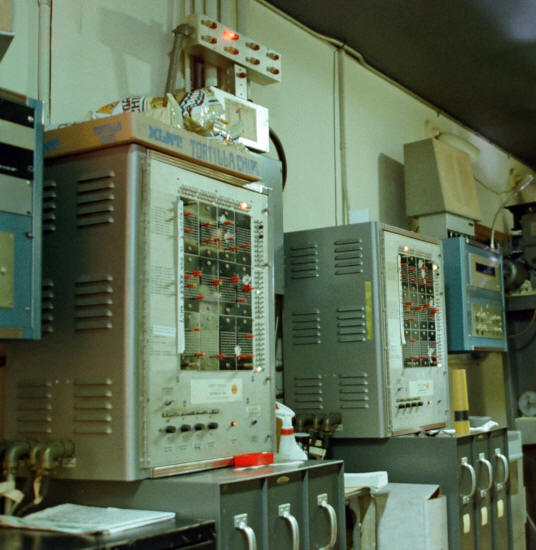 Rosemead
4 Theater. Primitive automation system (1981) Rosemead
4 Theater. Primitive automation system (1981)The time I really came to appreciate 70mm, was "My Fair Lady" in the spring of 1965. I had seen it in 35mm in a cinema back on the East Coast. I was already in college out in California. I went back to L.A. and I saw that "My Fair Lady" was showing in 70mm at The Egyptian Theatre, of all places. I went to see it again, on my own. It blew me away. Utterly fantastic! Incredible picture! Incredible sound! It was just... It was like a pie in the face. WOW! It made a massive impression, that one! Smell-O-Vision was a kind of a gimmick. That movie had been kind of, as they say now, "meh". But here was a top notch picture in a top notch venue, and I was immediately a total fan. And who would have thought that I would end up working there, years later? I gradually realised that there was all that stuff called 70mm out there. I tried to seek those shows out whenever I could. I was still in college, so I didn't have time to see everything. I had also started to work professionally in cinemas in L.A., through the Projectionist Union. THa: You had moved from the East Coast to the West Coast? Paul: My first two years of college, were in the east, at the University of New Hampshire. Then I took a year off to focus (pardon the pun!), and then resumed at University of Southern California in September of 1963. It was a good year. I first started projecting for the Cinema Department on campus. Presently - I don't remember how I found out - I learned that the Projectionist Union had offices just a few blocks from where the University was located. The Union membership at that time was six or seven hundred, with a lot of theatres under contract. There was always somebody that was sick or on vacation. I introduced myself to them in the autumn of 1964, and they started assigning me jobs. I worked everything in 35mm for quite some time. Before too long, I was assigned to some venue where eventually I ran 70mm. In those days, in the mid 1960s, any theatre showing a 70mm print would be what they called a "two-man booth", meaning two projectionists on duty at all times. So when I started working 70mm shows, I always had someone to check my work and offer hints, guidance and suggestions, etc. THa: In which cinemas? Paul: You name it, I was there, pretty much. Mainly ones that people know - The Chinese, The Paramount Theatre (now called El Capitan), Pantages, Egyptian, several of the major cinemas in downtown LA and dozens of places in the suburbs. All kinds, big and little. I knocked around on what they called the "extra board" for 15 years or so, and eventually paused for thinking. They had a process by which one could place a bid on a job. It was in '79, and I was beginning to get tired of the itinerant lifestyle, - you never knew where you were going to be, unless you are on a vacation gig for two or three weeks, which was nice, but so often you didn't know where you were going to be next week. I also worked in a screening room occasionally. |
|
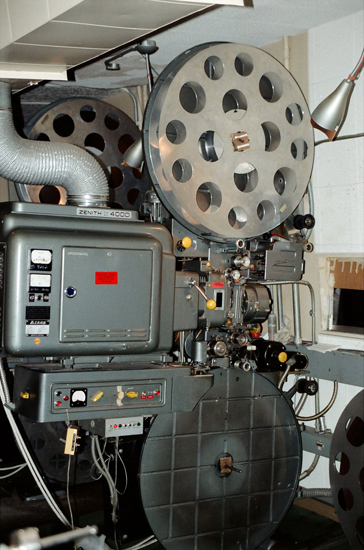 From
16mm at the Dartmouth College in
1960 to [7OMM at] the
AVCO in West LA in 1988. Cinemeccanica V-8 with big (BIG!) reels From
16mm at the Dartmouth College in
1960 to [7OMM at] the
AVCO in West LA in 1988. Cinemeccanica V-8 with big (BIG!) reelsStarting in March 1979, I won a job bid and began more predictable work in a four screen complex in a suburb called Rosemead. It was interesting, it was a multiplex, my introduction to the new world of multiple-screen cinemas. I learned more of the tricks of the way that theatres are run by penny pinching owners, when it was more important to them that I would come out and help them in the snackbars, fixing the plug on a butter machine or something, rather than paying attention to the fact that the film was running. There were four screens, each one had two projectors, where we would assemble the reels of the movie on to 6000 foot reels, which could run for an hour or so. There would be an automated changeover from one machine to the other. If you started out with "flat" previews of coming attractions, when your feature was 'scope presentation, you had to change the projection lens. You started out with the flat trailer, change to the other machine for the first roll of 'scope movie, then automated changes to the second roll of the 'scope movie. During the screening of one of the first Indiana Jones movies there I forgot to change the lens, of course, and nobody said beep. I was out there in the damned snackbar, fixing something and nobody realised that there was anything wrong until I came in at the end of the movie. "Oh! that's funny! The movie ran weird!" The four screens were built [in such a way] that you didn't have any kind of video monitor so you might see the problem and do something about it. Clever, huh? Screens #1 and #2 were in one projection room with the four machines, and then you had theatre #3 and #4 over in the other projection room. You might be in the "other" room anyway, when something went horribly wrong. I still have one souvenir of one incident at home. One day, the last reel of the movie split, the splice broke apart, but did not trip the fail safe to stop. The design was such that this could happen. It split right down the middle and presently I came in at the end of the movie, it was the last show of the night. I came in and found that one half of the reel, the film had wrapped up normally up on the take-up reel, but the other half had split off, right down the middle, like 17˝mm wide, on to the floor of the projection room! I have it still! I had to report that the film split. Paramount sent a replacement reel. So the next day, they were able to replace it in time for the first show. It was like someone took a knife and sliced it! Learning experiences were frequent but I never touched any 70mm in there for four years. Finally in early 1984, I won another job bid, this time to the quite famous "AVCO Theatre" in West L.A., and that was when I finally started encounting 70mm on an almost daily basis. It was the first THX "installation" in L.A. and very prominent. A few months later I was running the premiere of the original "Ghostbusters" in 70mm. By then, all commercial projection rooms were "solo", so I was on my own with a capacity crowd of, like, 1100 people, and you do feel the pressure in those circumstances. • Go to Life With THX In Hollywood Part 1 • Go to Life With THX In Hollywood Part 2 |
|
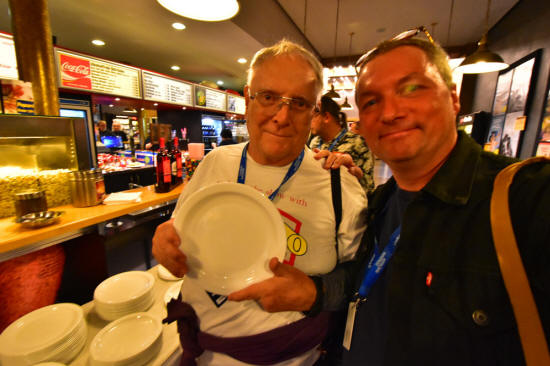 Paul
Rayton, in70mm.com's liaison man in Hollywood for 25 years. Always supportive, always
helpful.
Paul and Thomas of in70mm.com, have interviewed and
co-edited interviews with
many veterans of wide screen cinema. Unique teamwork. Seen here sharing
dinner in Karlsruhe. Paul
Rayton, in70mm.com's liaison man in Hollywood for 25 years. Always supportive, always
helpful.
Paul and Thomas of in70mm.com, have interviewed and
co-edited interviews with
many veterans of wide screen cinema. Unique teamwork. Seen here sharing
dinner in Karlsruhe.THa: What is it about 70mm that appeals to you? Paul: I like the magnificent image quality and the sound of the audio power of course. That's always the most rewarding thing for a projectionist. When you start it up and get the screen going, get the picture, turn the knobs and focus it. If the cinematographer was paying attention, it's a wondrous image to put on a screen. You know you are doing something for the audience with that. Plus the sound, plus the fact that I had an interest in trying to make a theatrical experience as good as it could be. Having worked in some dumpy houses, with sometimes old, even derelict 35mm, to get a chance to run some of the 70mm shows. Wow!, it's quite a difference. There's another good reason to like 70mm, because it helps keep your upper body in shape, with those heavy reels! But it is a mixed blessing. Many projectionists, later on, have developed problems with their backs and I'm not immune to them, because after a while, lifting all those 70mm reels can get to you. THa: Any favourite films among 70mm? Paul: I'm a big fan of "Lawrence of Arabia" and "West Side Story". THa: Why those particularly? Paul: I think they are visually well done. "Lawrence" in particular is visually striking. "West Side Story", I have always been impressed by the choreography of it and the use of the screen and the sound. When I first saw that one, it started out with the overture with the coloured abstract images of New York City and I didn't know what I was seeing. That was back in 1962 and only in 35mm (and probably mono sound), so I was still pretty much a viewing novice at that point, but it made a big impression on me. "Baraka" is a big favourite too. Visually stunning, again. The pictures are done well in that process. They are always particularly memorable. |
|
|
THa: What is your memory of Stanley Kubrick's "2OO1: A Space Odyssey", when it first came out? Paul: I think "2OO1" made a big impression on me too, on everybody, when it first came out. I saw it at the Warner Hollywood. So that would have been another early impression of 70mm. I still wasn't fully aware of the technical capabilities. I really hadn't worked those kinds of theatres. It was really amazing. You had that Stargate conclusion to it. - very trippy! THa: "Song of Norway" is generally considered "not a good film", and yet, it's good in 70mm, because the images are so sharp. Can a 70mm film be good for you if it's visually stunning and sharp, but the story is still kitsch? Paul: I can't speak to "Song of Norway" specifically, because I have never actually seen it as a "customer". I kind of like "The Sound of Music", I have to say. Wonderful visually. Let me put on my contrarian hat on: there are 70mm releases right now that have not done anything for me: "Inherent Vice" for example, I tried and tried and tried to get to enjoy that movie. It did not work, it will never work for me. It could be 150mm. It is still not going to work! But to answer your question, I'd say that, yes sometimes a 70mm presentation can elevate a modest production to a bit of an event. But not always. "The Hateful Eight"! That one has something to offend everybody. The aficionados, many of them are big fans. I am not a big fan of Tarantino's work, not least because of the super-bloody shootouts, that are so prevalent. The aspect ratio Tarantino chose for that one is gloriously wide but also very problematic. Also he seems to thrive on rubbing your nose in the strongest kind of language that he can manifest. "Hateful Eight", I loved the first half hour. The rest of it, you can have it. Starting with those exteriors, wonderful work! I am lukewarm on "Phantom Thread". Interesting movie, hmm, OK, the same is true of "Murder on the Orient Express". Why go and do that in 70mm? I don't follow quite that logical train. It does not make me feel like I am on on the train. THa: Is 70mm film different to run in Hollywood, compared with other places, with the film makers living next door? Paul: Probably, because if it is a big budget, high profile movie, and you are in one of the key theatres, they are likely to come by and see their show on "your" screen. You may not know it at the time, but you might. So it does add a degree of pressure to the job that you are doing. It is a double edged sword, because you have people nit-picking about the slightest error. On the other hand you can get additional technical help if you feel that there is something a little bit off. Maintain some contacts, because goodness knows they don't want to have their movie look bad on front of their peers! |
|
|
He did, he wrote it out. "Run this at seven and a half, Ridley Scott!"
And that was only a 35mm print. And as far as I know we never got any
complaints, I'm happy to say. The same sort of thing could have happened in
70mm. We opened
"Edward Scissorhands" in 70mm with Cinema Digital Sound.
That was a double whammy. We ran it for one day in 70mm and Tim Burton
did not like the way it looked. So they brought in a 35mm from the original
neg.
and that made him happy. The CDS (Cinema
Digital Sound) sound was OK, but, he retired the print after
just the one day.
They didn't toss out the print, but it was sent off to exile in San
Francisco I believe. |
|
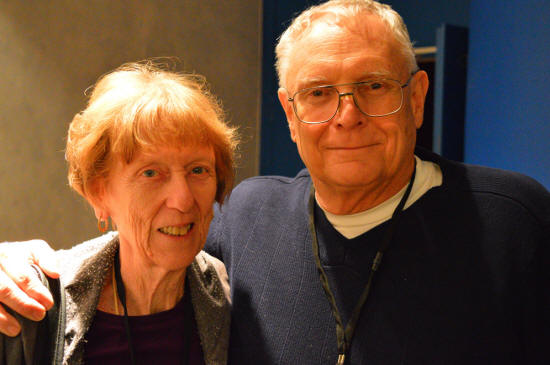 Paul
and Peggy during a quiet moment in Karlsruhe. Paul
and Peggy during a quiet moment in Karlsruhe.THa: Do you have any good celebrity stories to do with 70mm, from the projectionist angle. Paul: I can do one! Again, when I was working at the Avco in West LA. In June of 1988 we opened "Who Framed Roger Rabbit" in 70mm. And they were completely overwhelmed at the business this crazy film did. Thousands of people came to see it in 70mm. They were under staffed! We had the show on two giant reels. Ten thousand foot reels. I got the reels prepared and ready, and then I went downstairs and I told the Manageress, we are never going to get this show started unless we can get the people in. I tell you what, I will take the tickets, to just get people to go in. So I'm taking the tickets, "Thank you. Thank you", and there's this real tall guy coming in. A couple of people later, someone asked: "What film did Kareem Abdul-Jabbar see?" It hit me. I know who that guy was! Kareem! One of the most famous basketball players in the world at the time! I didn't recognize him when I saw him. Who else did I meet? I mentioned I worked a screening room for Charlie Aidikoff. His son didn't really have time to do the daily work of running the shows. He was in law school at the time. So one day, we are to be having a screening for Walter Matthau, and the print did not show up. So, we are there and there was nothing to do but just sit around and wait. So I was having a couple of snacks with Walter Matthau, trying to think of clever things to say. I was a little bit non plussed at that point. I didn't know what to say to a man of that stature. He was looking for a director for one of his projects. "Got any ideas?" My mind is a total blank at this point. Then there was Peter Lawford, one time, also in the same screening room. Mostly, Peter Lawford did more television work than movies so I didn't really know him by sight. I introduced myself. I thought he said Peter Wofford, so I went home. I said to my wife "who is that guy Peter Wofford?" She said "Peter Lawford?" Oh right! OK! I'm not really into all the movie gossip and stars. I wish I could have been more clever with Walter Matthau. I did the best I could. |
|
|
THa: I have a picture of you with Jacques Tati. Is that related to "Play Time"? Paul: Yes, it was in 1972, in front of The Chinese Theatre and part of The LA International Film Exposition - Filmex. The Filmex organisation eventually morphed into The American Cinematheque, which in 1999 became my employer for the next eighteen years. I guess it was "Play Time". They did a tribute to Tati. Most Hollywood riffraff I would not walk across the street for. Nor would I bother having a photo taken. But Tati was one of the few exceptions that I would certainly like to have a photo taken. So, that's where it was, in the courtyard of The Chinese. I also have a photo of me with Mark Magidson of "Baraka". That was a thrill. THa: I wonder what is it that motivates you to travel to Europe to see 70mm, and as often as you do? Paul: I met you and Johan [Wolthuis] through postal correspondence in the early '90s, and then you came to L.A. I found out through The 70mm Newsletter, then the Cinerama Society, which enthused me about the technical background, these processes are out there. Then I started hearing about Bradford being a place where you could run three-strip. I had worked for single-strip Cinerama in the Warner Hollywood, which was a good venue within the limits of 1930s building construction. I like to travel and so decided to go, to get out of town and sometimes I could recover a bit of the cost as a job-related expense. I could do a deduction and so get a little tax credit for professional enhancement. But I never got anything from an employer. Just interest in 70mm. I covered the cost by "raiding the cookie jar" at home. It got to be a bit addictive. So now I've been going to Karlsruhe, Krnov, Bradford. Been to one in Gothenberg, Sweden too. That was a very special group there. Somehow, it kind of seems silly to say it. I think the people I meet here [in Europe] are nicer and more interesting to me than certain of the 70mm geeks that I encounter in and around L.A. There are some that are OK, but some are a tad too eccentric for me. My primary good reference guy would be my colleague Michael Schleiger. He is extremely knowledgeable about the movies. He is still working, being four or five years younger than me. He can't stop working. I'd love to get him to come to a few of these events to see 7OMM + CINERAMA still done right. To have him come and see some of these shows. People who come here [Karlsruhe] seem to be interesting and interested and I like that. |
|
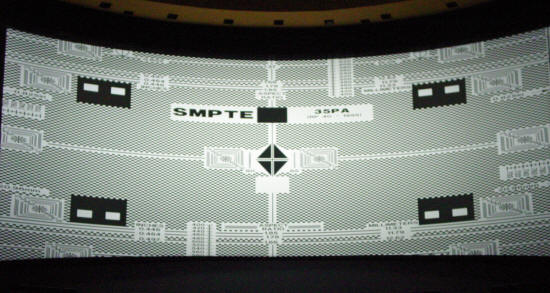 The
Dome Theatre has this issue with the curved screen. A lot of people love the
curved screen. It crops and distorts the picture something terrible. Take a
look at the cropping in the bottom center as compared with the lower left +
right corners. It's distressing to me. Here, once again, I'm being a bit of
a contrarian. The
Dome Theatre has this issue with the curved screen. A lot of people love the
curved screen. It crops and distorts the picture something terrible. Take a
look at the cropping in the bottom center as compared with the lower left +
right corners. It's distressing to me. Here, once again, I'm being a bit of
a contrarian.THa: What are the best 70mm cinemas in your opinion? Even those you worked in? Paul: The Egyptian, The Schauburg - Those two would be the top of my list. Mainly because of being particularly well acquainted with them. I don't know the tech specs of some other famous houses - I don't trust exhibition in New York City. People say it's OK, but I'm not too sure. The screens in central Texas (Dallas area) maintained by Brad Miller would be good to visit, as he is very particular about technical perfection. I say Egyptian and Schauburg, because they are big screens, with good sound, both of which are very important. I don't trust big names like The Chinese. The El Capitan does not do film anymore. The Dome Theatre has this issue with the curved screen. A lot of people love the curved screen. It crops and distorts the picture something terrible. It's distressing to me. Here, once again, I'm being a bit of a contrarian. When the cinematographer is making the picture and getting the dimensions and the composition and the frame, he's expecting it to be shown that way, but when you put it on the curved screen, usually the bottom of the picture gets chopped off. It's very disturbing to me so I can't really give a positive review to one of my otherwise favourite theatres, The Dome. When they opened "Evita" in late 1996, Sir Alan Parker had enough clout so they actually installed a flat screen in The Dome because he declared that he was not going to have his picture shown on that deep curve, because the curvature ruins the composition. in 2014, the actor Tommy Lee Jones directed a movie "The Homesman". It was a scope film and was scheduled to be run at the Dome as part of the AFI Festival that year. He objected to the distortion of the screen for the wide exteriors as well as having a problem about the cross reflections on the curved screen, not like the proper screen as in Bradford, which has a louvered screen. So the show was quickly transferred to the Egyptian. |
|
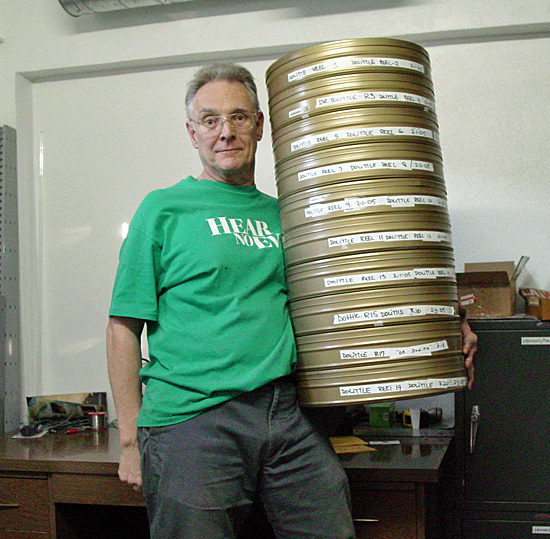 Paul
Rayton at the Egyptian 2005. The 70mm cans are empty, you better believe it. Paul
Rayton at the Egyptian 2005. The 70mm cans are empty, you better believe it.THa: What do you prefer when you watch movies? Can you describe what it is that appeals to you at The Egyptian as a 70mm house? Paul: Big flat screen, big matte, meaning a big black field around the picture that really separates the picture from all the distractions around it. That style is contemporary design preferences so that the thing is pretty much black everywhere so you can have good contrast. The picture is pretty important. The other thing that is good is that unlike most cinemas, much of the floor of the Egyptian is wood supporting the stadium seating. There is a natural resonance, if you will, to the audio playback with that wood floor instead of the hardness of the typical concrete. It gives it an audio ambiance that is better. The first time it struck me was when we first started running "Baraka" in there in 70mm. "My God, this playback sounds incredible!". Its probably overstating it, but I liked to call it the "Carnegie Hall Effect". THa: What is the perfect 70mm show to you? Paul: Curtain, Overture, maybe an intermission if it's a long show. Wonderful cinematography, good looking print and top notch sound and a good story from a very good script. That's a laundry list that one could check off. And sufficient, proper presentation! It's got to have enough light behind it, for example. Sometimes that's a hard item to find, sufficient light. THa: You have been proofreading everything for in70mm.com, which I [and others] have written for twenty odd years or so. Many of my interviews always end with the same question ... do you have anything you want to add? Paul: Once in a while, there are phrases from you that stand out in the draft version, and I call them "Thomasisms". I think it mostly comes from the fact that I am a native English speaker, while your English - while good - is still a second language. So sometimes things that sound the same, but are not exactly the same, slip through. There is one in particular: exciting vs. exiting. It often comes out from you as exiting. "The movie was exiting". You are supposed to have the letter C in there, as "The movie was exciting!" Exiting means people were leaving or departing! Oops! I'm glad that I can catch those, because "exiting" appears fine to spell check or a computer, so it would confuse your readers! I have fun looking for the Thomasisms! |
|
Addendum / Part Deux
|
|
|
• 16mm lab work at USC, San Diego • The Rose Bowl show • Seeing Cinerama in 1960 and possibly a few other things, and some other photos. COMING SOON! |
|
| Go: back - top - back issues - news index Updated 22-01-25 |

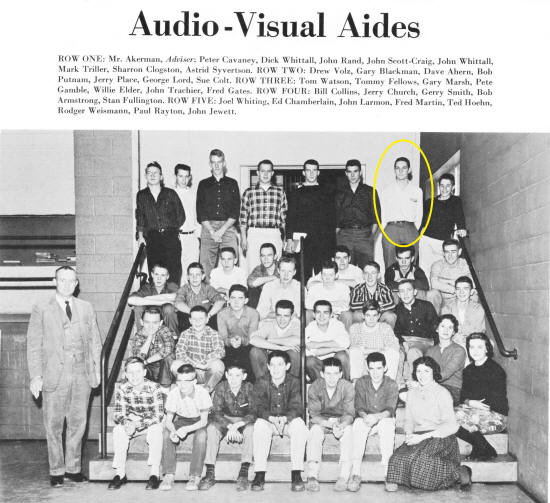
 Dartmouth
College - Fairbanks Hall "theater", circa 1960
Dartmouth
College - Fairbanks Hall "theater", circa 1960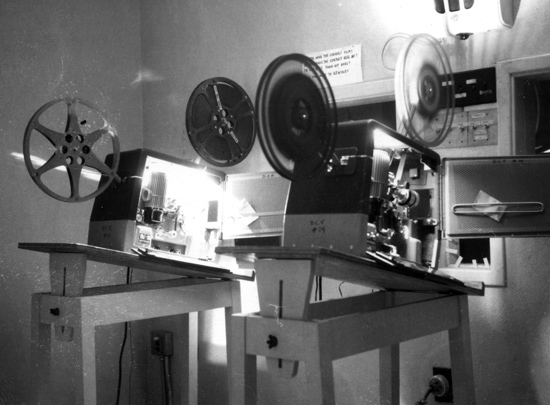 Dartmouth
College - Fairbanks Hall projection room, circa 1960 (time exposure,
Polaroid original)
Dartmouth
College - Fairbanks Hall projection room, circa 1960 (time exposure,
Polaroid original)